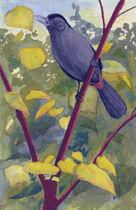|
Dock of the Bay
 Share the Chesapeake Share the Chesapeake
But keep your fishing line to yourself
You feel safe. You pop open a beer, pull your cap down over your eyes and relax in the sweet relief of solitude; your line dangles overboard waiting for a bite.
But you’re not alone.
Lurking overhead, another fisher watches your every move with hawk eyes. And not just any fisher, but one who could swoop in to steal your catch before it even takes your bait.
Your competition is a four-pound bird: an osprey, who’s out there working hard to feed his family.
Like you, osprey were born to fish.
A cousin to the falcons, they are the only hawks with an outer reversible toe, enabling them to grasp their prey with two toes in front and two in back. With the precision of an army sharpshooter, at 70 feet above sea level the male identifies his prey, hovers, then dives at speeds up to 40 miles an hour. Approaching the water feet first, he grasps the fish with his vise-like talons and flies off with his catch.
If you could do that, your afternoons wouldn’t be so lazy, but they would be much more productive.
The osprey eats the head and eyes first, before bringing the rest of the fish to his mate in the nest, where she’ll use her strong neck and sharp beak to tear it apart to feed herself and her young, usually two or three chicks each year.
 Feeding so many hungry mouths takes a lot of fish. Still, you’re more of a danger to the osprey than he to you. Feeding so many hungry mouths takes a lot of fish. Still, you’re more of a danger to the osprey than he to you.
After surviving near extinction from the pesticide DDT, your fellow fisher now must survive you.
More than half of osprey nests on the Bay and surrounding rivers contained fishing line, the U.S. Fish and Wildlife Services discovered in a 2003 survey. The survey also discovered worse sights: ospreys entangled in fishing lines or impaled with fishing hooks.
Osprey build their nests high and over water to avoid raccoons and to be close to the water that’s their hunting ground. Building on telephone poles and navigational markers, they lay branches and whatever catches their eye into a nest about the size and shape of an overflowing tire. Discarded fishing line is just one more raw material to these tireless homebuilders.
But the line can be deadly. Parents and their offspring can suffocate or become entangled and unable to fly.
Maryland’s 1,600 breeding pairs of ospreys live or die by the courtesy or the carelessness of the state’s 44,232 licensed anglers.
So the next time you sneak off for a day of fishing, remember your fishing buddy overhead. Pick up discarded line for safe disposal. Beachcombers can help, too. When you see a piece of line, pick it up and save an osprey.
— Louis Llovio
to the top
 Ask the Plant Professor Ask the Plant Professor
Two Nuisances: Squirrels and Poison Oak
Q Squirrels are chewing new growth (four- to eight-inch twigs) off my trees, then dropping them. Last year they ate pine cones. The trees look terrible. Will this harm the trees?
A Your squirrels are exhibiting perfectly normal behavior for a squirrel. Squirrel front teeth grow constantly and need to be filed down by gnawing on twigs (and perhaps pine cones) to keep them from becoming too sharp. Trees and squirrels have coexisted for eons, and this activity should not harm healthy trees.
Q Should I be on the lookout for poison oak?
A Poison oak is not common in Maryland. It is a shrub, unlike poison ivy, with rounded lobed leaves like white oak, in sets of three. It causes a skin rash similar to poison ivy. It occurs along the fall line where the coastal plain-merges into the piedmont (from Washington D.C. to Baltimore) and on the lower Eastern Shore.
Ask the Plant and Pest Professor is compiled from questions sent to the website of the Home and Garden Information Center, part of Maryland Cooperative Extension, an educational outreach of the University of Maryland. Ask a home gardening or pest control question and find other help: 800-342-2507 (Mon.-Fri. 8am-1pm) • www.hgic.umd.edu.
to the top
Navy Lacrosse Plays for Championship and Country
Navy loses close game on Memorial Day
One goal.
That’s how close it was. One goal in a game full of them.
That one goal would have tied the NCAA Lacrosse Championship game for Navy. One goal and they would have evened the score in a very competitive game against perennial champion Syracuse University.
They didn’t get it.
Navy lost the game 14-13 in front of 43,898 lacrosse fans at Raven’s stadium in Baltimore.
 That missing goal takes perspective in context. Navy has finished games by such a razor-thin margin five times this season. Before Monday, they’d won four of the five. That missing goal takes perspective in context. Navy has finished games by such a razor-thin margin five times this season. Before Monday, they’d won four of the five.
“I’m obviously disappointed,” said head coach Richie Meade. “But I’m very proud of our team.”
This could have been the first NCAA Lacrosse Championship in Navy’s history. 1975 was the only other year they played in the penultimate game.
Syracuse, by contrast, has won nine championships, with this year’s the fourth in 10 years.
Timing added significance; the game was played on Memorial Day.
“It was an honor to play here today,” said sophomore player Ian Dingman. “Playing on Memorial Day makes it extra special. Honoring veterans in all the wars, I hope they aren’t anything but proud of us.”
“Today was very emotional” added Syracuse head coach John Desko. “This championship game was very different because of our opponent. They played with a bigger cause, and to go out and play them, it didn’t have the feel of a typical opponent.”
— Louis Llovio
to the top
Earth Journal: Gray Catbird
Story and illustration by Gary Pendleton
Sometime last month, the catbirds returned after having spent the fall and winter in Central America. With luck, a pair will build their nest in the dense brush growing around the house and will be part of the summer scene at home for a few months. Along with the tomatoes, peppers and bean plants, hummingbirds, flowers and butterflies, their presence will liven up the place. They are a most welcome summer visitor. Unpretentious and entertaining, they will leave too soon.
From late April to mid May, a wave of migrating birds passes over the land. During those weeks, birders rise early to drive many a mile to the forests, marshes and fields, seeking out the most colorful and elusive species of migrants. The wave is comprised of dozens of species that spend the winter in Central America. Many of the neo-tropical migrants — such as the scarlet tanager, Baltimore oriole and most of the warblers — are known for their rich colors. Some are passing through to New England and Canada and will be here for just a few days.
 Catbirds are part of that wave, but they are not one of the richly colored species. Neither are they making a brief appearance while passing through to distant places. Birders do not rise at 4am and travel to remote locations to catch a glimpse of the elusive catbird. Their migration journey is just as long and difficult as their cohorts, but they do not put on airs and play hard to get. Compared to the scarlet tanager, for example, they do not exude an exotic, tropical bearing. They are quite common and just as likely to be in a back yard as a wildlife sanctuary — especially if the back yard has a bird bath, because the cat bird likes to get wet. Catbirds are part of that wave, but they are not one of the richly colored species. Neither are they making a brief appearance while passing through to distant places. Birders do not rise at 4am and travel to remote locations to catch a glimpse of the elusive catbird. Their migration journey is just as long and difficult as their cohorts, but they do not put on airs and play hard to get. Compared to the scarlet tanager, for example, they do not exude an exotic, tropical bearing. They are quite common and just as likely to be in a back yard as a wildlife sanctuary — especially if the back yard has a bird bath, because the cat bird likes to get wet.
Catbirds are slim, elegant birds. Their shape is similar to that of their close relation, the mockingbird, but they are a little smaller. Their color is slate gray with a black cap covering the head and nape of the neck. Their proper name is gray catbird. A catbird will occasionally flash a little patch of rusty red plumage by raising its tail and revealing a part of anatomy delicately termed the undertail coverts.
Like mockingbirds, catbirds are mimics but their ability to imitate sounds is not so highly developed. Their song, according to the National Geographic Field Guide sounds like “a various mixture of melodious, nasal and squeaky notes interspersed with catlike mew notes.” It really is a very catlike mew, so the name fits.
The name fits for another reason. Many folks have observed that cat birds and mockingbirds seem to have a special dislike for house cats. The birds get agitated and display their enmity with vocal harassment. Mockingbirds can become aggressive to the point of dive-bombing the earthbound feline.
|
Cicada Song
by Bert J. Hubinger
You think you’re more to me
than I am to you! But I’ll burrow
under your soil
for another 17 years,
buried in the past
but ringing in your memory like a plague
of love and hate,
and after all those years, like magic,
I’ll crawl out again
and hook on a tree,
sucking sap, clawing a cicada tune,
humming a few shrill bars
that you’ll remember,
a love song resonating
at the core of your loneliness;
summer lost, I’ll shriek and hiss,
and you’ll miss me again,
for I have crawled these
seventeen summers to the surface
to break out my wings
and die in one last skin,
our brief passion spent,
splitting the wet,
hot night with a buzzing curse,
devoured at last,
cicada!
Hubinger, formerly of the Naval Institute, teaches at Anne Arundel Community College. “Cicada Song” is from Sea Drums and Other Poems, available at www.amazon.com
|
We had an old cat named Jynx who liked to spend the summer napping on a porch near a dense quince bush where the catbirds had a nest. I’m told Jynx was once a good mouser, but by the time I made her acquaintance, she had aged into timid, arthritic senility. She was a pretty, long-haired black cat with green eyes; and at six pounds, she was the smallest cat I’ve ever seen.
Jynx was living out her final years too stiff and tired to be a threat to any creature. But the catbirds didn’t see it that way. Day after day, they defended the nest, harassing the old cat with scolds and ruffled feathers. Jynx was totally unfazed; she was too tired to move and too deaf to hear the catbirds’ scolding calls. We enjoyed the show.
Jynx is gone, but the catbirds and their offspring keep coming back.
to the top
Way Downstream …
From Assateague Island National Seashore comes bad news for vacationers. Assateague was one of 12 parks surveyed that is suffering from a combination of cuts in budget, staff and visitor services, according to a survey last week by the 250-member Coalition of Concerned National Park Service Retirees. In March, the Bush Administration said deep cuts would not occur…
In Miami, look out for Danielle, Gaston and hopefully not Walter. Those are among the names in alphabetical order for this year’s Atlantic-Caribbean storms, and the prediction this year is that there could be as many as 14 named storms, possibly eight that become hurricanes…
In Norway, Europeans showed once more last Friday why they are more civilized than Americans: One of the Nordic region’s biggest power stations closed so that an expert could tune its grand piano without the humming of machines…
Our Creature Feature comes from Austria, where soon chickens will run free, big cats will retire from circus gigs and floppy ears will be the style for Dobermans.
Members of the Austrian Parliament, some cradling stuffed animals, last week unanimously passed one of the world’s most sweeping anti-cruelty laws. “Austria is taking the role of pioneer,” trumpeted Austrian Chancellor Wolfgang Schuessel.
to the top
|



 Feeding so many hungry mouths takes a lot of fish. Still, you’re more of a danger to the osprey than he to you.
Feeding so many hungry mouths takes a lot of fish. Still, you’re more of a danger to the osprey than he to you.
 That missing goal takes perspective in context. Navy has finished games by such a razor-thin margin five times this season. Before Monday, they’d won four of the five.
That missing goal takes perspective in context. Navy has finished games by such a razor-thin margin five times this season. Before Monday, they’d won four of the five.  Catbirds are part of that wave, but they are not one of the richly colored species. Neither are they making a brief appearance while passing through to distant places. Birders do not rise at 4am and travel to remote locations to catch a glimpse of the elusive catbird. Their migration journey is just as long and difficult as their cohorts, but they do not put on airs and play hard to get. Compared to the scarlet tanager, for example, they do not exude an exotic, tropical bearing. They are quite common and just as likely to be in a back yard as a wildlife sanctuary — especially if the back yard has a bird bath, because the cat bird likes to get wet.
Catbirds are part of that wave, but they are not one of the richly colored species. Neither are they making a brief appearance while passing through to distant places. Birders do not rise at 4am and travel to remote locations to catch a glimpse of the elusive catbird. Their migration journey is just as long and difficult as their cohorts, but they do not put on airs and play hard to get. Compared to the scarlet tanager, for example, they do not exude an exotic, tropical bearing. They are quite common and just as likely to be in a back yard as a wildlife sanctuary — especially if the back yard has a bird bath, because the cat bird likes to get wet.